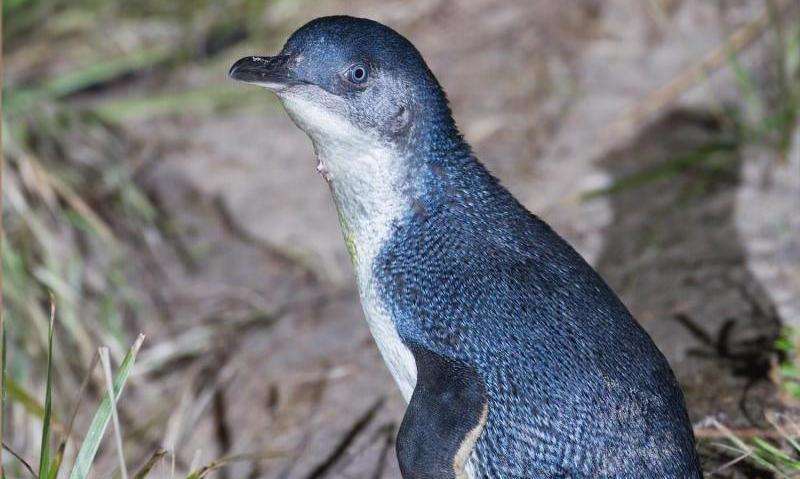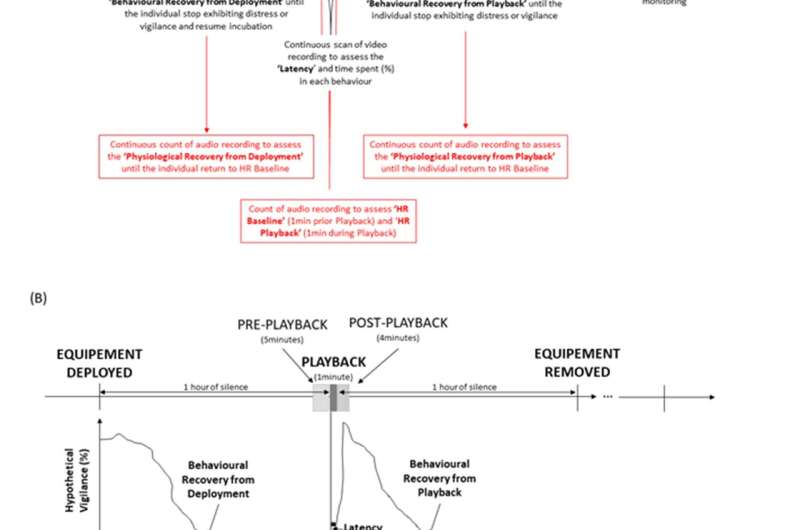Little Penguin (Eudyptula minor), Bruny Island, Tasmania, Australia. Credit: JJ Harrison/Wikipedia
Thanks to Flinders University researchers collaborating with the Department of Environment & Water and Green Adelaide, the creation of the new signs that identifies intrusive human interactions provides timely support for a colony that had shrunk to only 16 animals in early 2020.
These signs were developed in response to an increase in human and dog disturbances on Granite Island since 2016. Specifically, disturbances at night increased from less than 2% of the monitored nights before 2016 to more than 20% of the nights in 2017 and onwards. Disturbances include unauthorized dogs (on or off leash), bikes and people wandering or actively searching for penguins using white torches or flashes (Colombelli-Négrel 2019, 2020).
The population of wild Little Penguins on Granite Island in South Australia has been the subject of intensive study by Flinders University researchers since 2012—but this research was under threat during 2020 after disruptions to nightly monitoring of the penguins.
Fortunately, the input of citizen scientists and Flinders student volunteers have provided the solution to a threatened environmental analysis program.
Dr. Diane Colombelli-Négrel, Flinders University Lecturer in Animal Behavior and a principal investigator of Birdlab research group, is South Australia's only Penguin Ecologist and is thrilled by the volunteers' enthusiasm.
This includes the contribution of Flinders student Lauren Common, Ph.D. student in the BirdLab, who created the artwork for the new penguin safety signs—as well as for the yellow tops that volunteers wear at night to conduct penguin surveys.
Figure S1. (a) Schematics of the experimental steps and measurements collected for each individual. (b) Hypothetical change over time of the vigilance behaviour of an individual in response to the deployment and playback.
"Compiling data about the penguins had been conducted by guides hosting nightly tours of Granite Island—but the combination of COVID-19 restrictions on gatherings, and attacks by foxes that almost halved the Little Penguin population to only 16 animals, meant that the nightly tours stopped," says Dr. Colombelli-Négrel.
Volunteer involvement rescued the research program. From October 2020, several Flinders University students living in the Victor Harbor area answered the call to join a volunteer roster—including Lucinda Gray, Maddie Turley and Nicole Fickling, along with an enthusiastic collection of other local residents—to monitor the penguins each night, and the research program is once again robust.
This has led to continuing research being published about little penguin behavior throughout South Australia—including a paper focused on populations at Emu Bay in Kangaroo Island and Troubridge Island, titled "Behavioral and heart rate responses to stressors in two populations of Little Penguins that differ in levels of human disturbance and predation risk," by Dr. Colombelli-Négrel and Rebecca Schaefer, published in Ibis: International Journal of Avian Science.
"Our study supports the idea that populations exposed to constant and unpredictable disturbance (such as predator, human or conspecifics in a closed habitat) display elevated behavioral and physiological responses to threats compared with those in less disturbed areas, and that guidelines for managing penguin species cannot be generalized across species or populations," says Dr. Colombelli-Négrel.
Dr. Colombelli-Négrel has trained the group of Granite Island volunteers to record specific information about the behavior of the Little Penguins—including their feeding, molting and mating cycles—and most importantly to not disturb the birds, especially by not exposing them to white torch light.
"It's an important two-way information process. Not only do we assess the behavior of individual Little Penguins, but the program also has an influence on human behavior," says Dr. Colombelli-Négrel. "Through studying the effects of human disturbance on Little Penguins, we can help prevent any further shrinkage of their population."
The annual public census of Little Penguins on Granite Island, held in October each year, attracted the largest group of volunteers in 2020, with 65 helpers—including 10 Flinders students—spending a day to count and locate active burrows all around the island. What they found is encouraging, noting that the remaining adult Little Penguins on Granite Island are breeding.
"Our work is making a difference," says Dr. Colombelli-Négrel, "and it shows the input of citizen scientists working at its best."
More information: Rebecca Schaefer et al. Behavioural and heart rate responses to stressors in two populations of Little Penguins that differ in levels of human disturbance and predation risk, Ibis (2021). DOI: 10.1111/ibi.12925
Provided by Flinders University

























